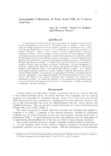Sustainable Utilization of Poor Acid Soils of Tropical America
Tropical agriculture research series : proceedings of a symposium on tropical agriculture researches
| ISSN | 03889386 |
|---|---|
| 書誌レコードID(総合目録DB) | AA00870529 |

本文フルテキスト
tars24-_133-145.pdf2.66 MB
Tropical America's 800 million hectares of savannas and forests are characterized by the predominance of acid Oxisols and Ultisols with low fertility. These frontier lands are being incorporated into the region's agricultural production area. Landclearing and intensification of areas close to infrastructure cause the degradation of natural resources. There is thus a need to develop higher-yielding sustainable production systems. CIAT strategies to reduce pressures for land- clearing in fragile environments include the development of sustainable agropastoral production systems for less fragile savanna environments and the reclamation of already degraded forest lands by the replacement of extensive ranching and shifting cultivation with sustainable agrosivilvopastoral systems. To achieve these specific strategies, it is necessary to promote efficient input use based on adapted components; low-cost management to maximize outputs and effectively use natural and purchased inputs in minimizing negative environmental effects; and maximizing nutrient cycling. New, adapted grass-legume pastures, upland rice, maize, sorghum, soybeans and cassava cultivars are becoming available. Crops can pay for upgrading soil fertility to establish pastures and tree components. Grass-legume pastures with deep and profuse roots can reduce erosion and improve the physical chemical and biological soil conditions for subsequent cropping. To realize the potential of these sustainable integrated systems on poor acid soils, technologies must be based on commercially valuable, ecologically compatible, adapted components.
| 刊行年月日 | |
|---|---|
| 作成者 | Jose M. Toledo Robert S. Zeigler Filemon Torres |
| 公開者 | Japan International Research Center for Agricultural Sciences |
| 巻 | 24 |
| 開始ページ | 133 |
| 終了ページ | 145 |
| 言語 | eng |
